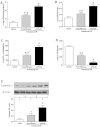Protective effects of fenofibrate against acute lung injury induced by intestinal ischemia/reperfusion in mice
- PMID: 26902261
- PMCID: PMC4763198
- DOI: 10.1038/srep22044
Protective effects of fenofibrate against acute lung injury induced by intestinal ischemia/reperfusion in mice
Abstract
This experiment was conducted to evaluate whether pretreatment with fenofibrate could mitigate acute lung injury (ALI) in a mice model of intestinal ischemia/reperfusion (I/R). Male C57BL/6 mice were randomly assigned into three groups (n = 6): sham, intestinal I/R + vehicle, and intestinal I/R + fenofibrate. Intestinal I/R was achieved by clamping the superior mesenteric artery. Fenofibrate (100 mg/kg) or equal volume of vehicle was injected intraperitoneally 60 minutes before the ischemia. At the end of experiment, measurement of pathohistological score, inflammatory mediators and other markers were performed. In addition, a 24-hour survival experiment was conducted in intestinal I/R mice treated with fenofibrate or vehicle. The chief results were as anticipated. Pathohistological evaluation indicated that fenofibrate ameliorated the local intestine damage and distant lung injury. Pretreatment with fenofibrate significantly decreased inflammatory factors in both the intestine and the lung. Consistently, renal creatine levels and hepatic ALT levels were significantly decreased in the fenofibrate group. Moreover, serum systemic inflammatory response indicators were significantly alleviated in the fenofibrate group. In addition, fenofibrate administration significantly improved the survival rate. Collectively, our data indicated that pretreatment with fenofibrate prior to ischemia attenuated intestinal I/R injury and ALI.
Figures






Similar articles
-
Anti-inflammatory and antioxidant effects of infliximab on acute lung injury in a rat model of intestinal ischemia/reperfusion.J Mol Histol. 2012 Jun;43(3):361-9. doi: 10.1007/s10735-012-9396-0. Epub 2012 Mar 3. J Mol Histol. 2012. PMID: 22389028
-
FK866, a visfatin inhibitor, protects against acute lung injury after intestinal ischemia-reperfusion in mice via NF-κB pathway.Ann Surg. 2014 May;259(5):1007-17. doi: 10.1097/SLA.0000000000000329. Ann Surg. 2014. PMID: 24169192
-
Inhibitor of apoptosis-stimulating protein of p53 inhibits ferroptosis and alleviates intestinal ischemia/reperfusion-induced acute lung injury.Cell Death Differ. 2020 Sep;27(9):2635-2650. doi: 10.1038/s41418-020-0528-x. Epub 2020 Mar 18. Cell Death Differ. 2020. PMID: 32203170 Free PMC article.
-
Cyclic arginine-glycine-aspartate attenuates acute lung injury in mice after intestinal ischemia/reperfusion.Crit Care. 2013 Jan 29;17(1):R19. doi: 10.1186/cc12493. Crit Care. 2013. PMID: 23360591 Free PMC article.
-
Cellular Signal Transduction Pathways Involved in Acute Lung Injury Induced by Intestinal Ischemia-Reperfusion.Oxid Med Cell Longev. 2021 Jun 4;2021:9985701. doi: 10.1155/2021/9985701. eCollection 2021. Oxid Med Cell Longev. 2021. PMID: 34188755 Free PMC article. Review.
Cited by
-
Hypoproteinemia is an independent risk factor for the prognosis of severe COVID-19 patients.J Clin Biochem Nutr. 2020 Sep;67(2):126-130. doi: 10.3164/jcbn.20-75. Epub 2020 Aug 6. J Clin Biochem Nutr. 2020. PMID: 33041508 Free PMC article.
-
Cobra Venom Factor-induced complement depletion protects against lung ischemia reperfusion injury through alleviating blood-air barrier damage.Sci Rep. 2018 Jul 9;8(1):10346. doi: 10.1038/s41598-018-28724-z. Sci Rep. 2018. PMID: 29985461 Free PMC article.
-
Perioperative "remote" acute lung injury: recent update.J Biomed Res. 2017 Jan 19;31(3):197-212. doi: 10.7555/JBR.31.20160053. J Biomed Res. 2017. PMID: 28808222 Free PMC article.
-
The potential role of ischaemia-reperfusion injury in chronic, relapsing diseases such as rheumatoid arthritis, Long COVID, and ME/CFS: evidence, mechanisms, and therapeutic implications.Biochem J. 2022 Aug 31;479(16):1653-1708. doi: 10.1042/BCJ20220154. Biochem J. 2022. PMID: 36043493 Free PMC article. Review.
-
Chinese Herbs and Repurposing Old Drugs as Therapeutic Agents in the Regulation of Oxidative Stress and Inflammation in Pulmonary Diseases.J Inflamm Res. 2021 Mar 4;14:657-687. doi: 10.2147/JIR.S293135. eCollection 2021. J Inflamm Res. 2021. PMID: 33707963 Free PMC article. Review.
References
-
- Rubenfeld G. D. et al. Incidence and outcomes of acute lung injury. N Engl J Med. 353, 1685–1693 (2005). - PubMed
-
- Mabbott N. A. et al. Aging and the mucosal immune system in the intestine. BIOGERONTOLOGY. 16, 133–145 (2015). - PubMed
-
- Moraes L. B. et al. Gut ischemia/reperfusion induced acute lung injury is an alveolar macrophage dependent event. J Trauma. 64, 1196–1200, 1200–1201 (2008). - PubMed
-
- Zhao W. et al. The interaction between oxidative stress and mast cell activation plays a role in acute lung injuries induced by intestinal ischemia/reperfusion. J SURG RES. 187, 542–552 (2014). - PubMed
Publication types
MeSH terms
Substances
LinkOut - more resources
Full Text Sources
Other Literature Sources

